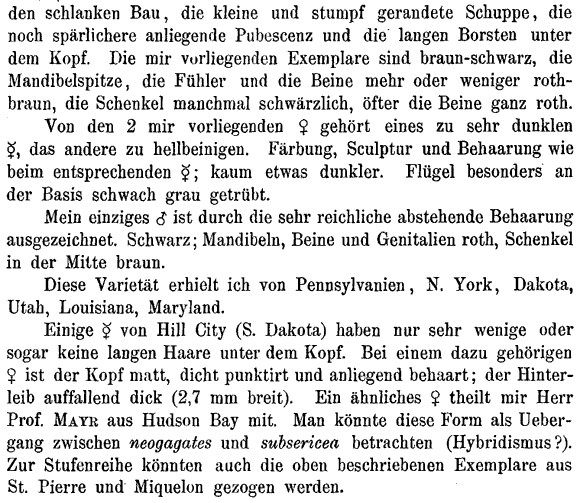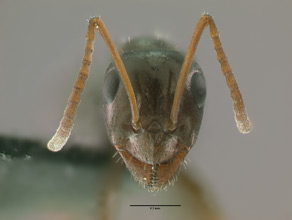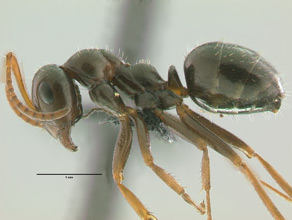- Identification
- Slightly smaller than medium-sized workers. Their shiny integument and smaller size place these Formica ants in the neogagates species group. Formica neogagates can be separated from other Navajo Reservation neogagates group species by the combination of the absence of standing hairs on their antenna (unlike Formica lasioides) and the smoothly curving anterior edge of their clypeus (Formica perpilosa has a notched clypeus). Workers are black or very dark brown, with the gaster typically being darker colored than the rest of the body.
- Biology
- In the eastern part of its range this species is a forest inhabitant. Beyond this region it may be found in woodlands, grasslands and prairies. Colonies are small, consisting of a few hundred workers, and may have one or multiple queens. Soil nest entrances can be located under a covering object, marked by a small soil crater or, less often, are unmarked openings in the ground. They will also nest in leaf litter, downed wood and stumps.
- additional biology notes...
- Distribution
- Range
- S Canada and United States. Absent in the southeastern US, and the middle and southern areas of the midwest. Future revisions will likely reveal there are a number of valid species that are subsumed under this species name.
- Navajo Reservation Records
- Collection records being processed.
- Additional Notes
- This species faces trouble from other ants on two fronts. First, it is enslaved by sanguinea group Formica species. Second, they are likely parasitized by other Formica ants that have queens that start new nests by invading heterospecific Formica colonies. Formica neogagates foragers are omnivores, will tend aphids and are rather timid.
- In the western part of its range this species name is likely just a convenience. There are believed to be a number of unnamed neogagates species in this region.
- Etymology
- Morphological. Named for its resemblance to a Paleartic Formica species; neos = new + gagates = jet black


- Literature
- Emery, C. 1893. Beiträge zur Kenntniss der nordamerikanischen Ameisenfauna. Zoologische Jahrbücher, Abteilung für Systematik, Geographie und Biologie der Tiere. 7:633-682.
- Viereck, H. L. 1903. Hymenoptera of Beulah, New Mexico. [part]. Transactions of the American Entomological Society (Philadelphia). 29:56-87.
- A note about these publications. The literature cited here is not meant to be an exhaustive list of papers published about this species.
Page authored by David Lubertazzi and Gary Alpert


